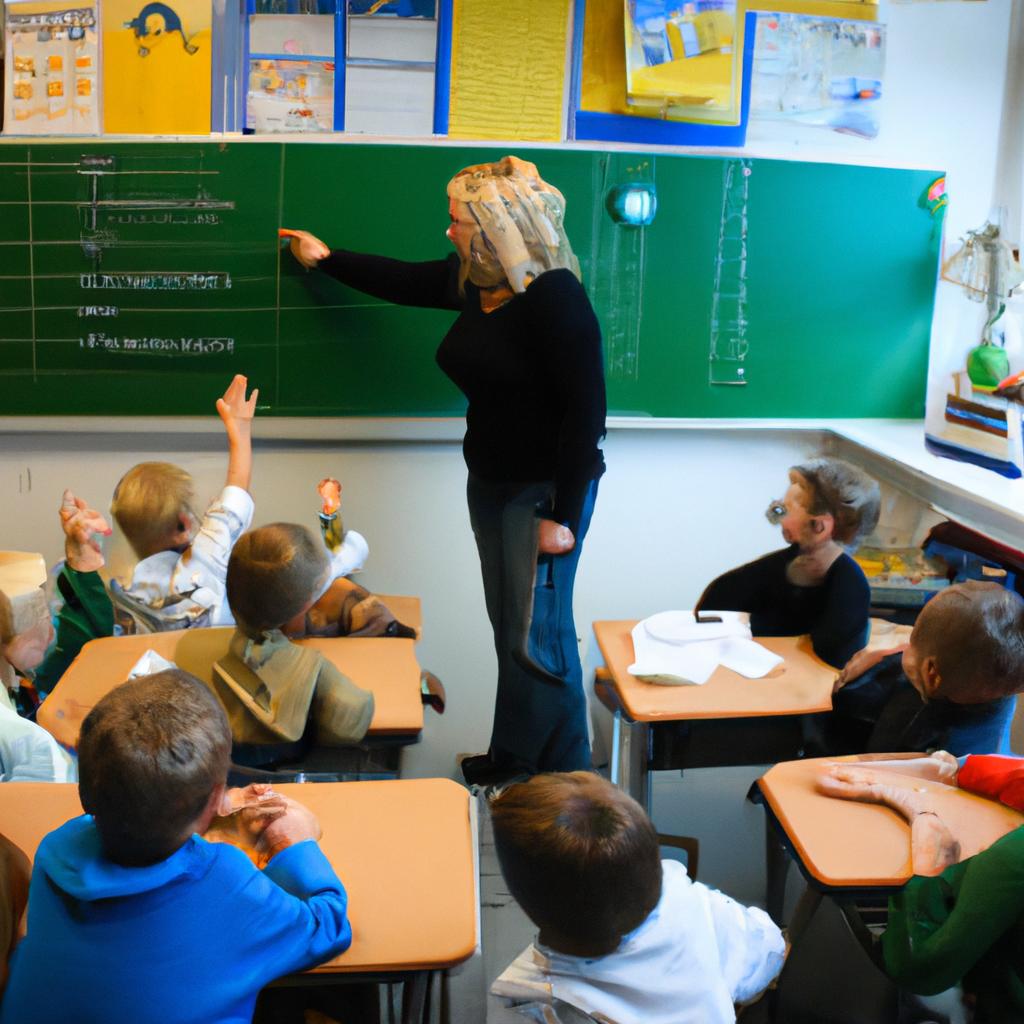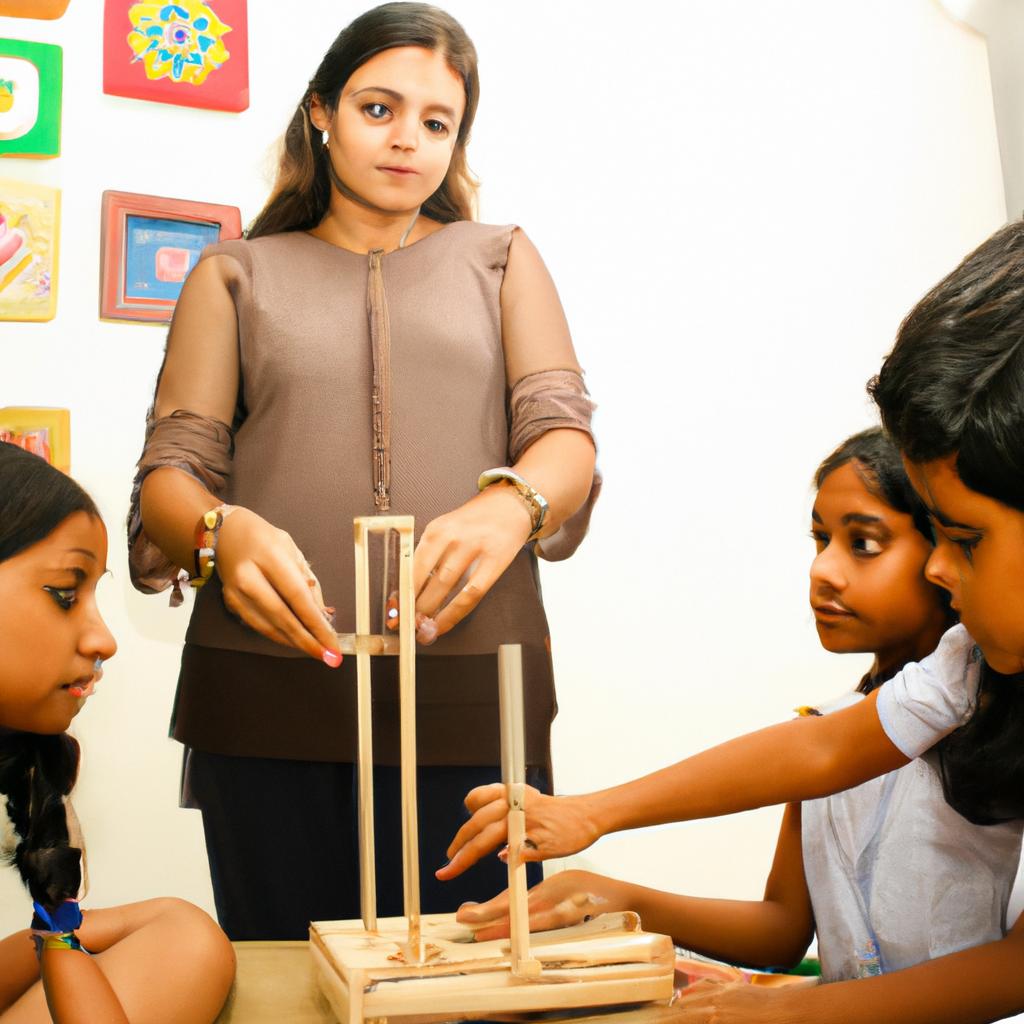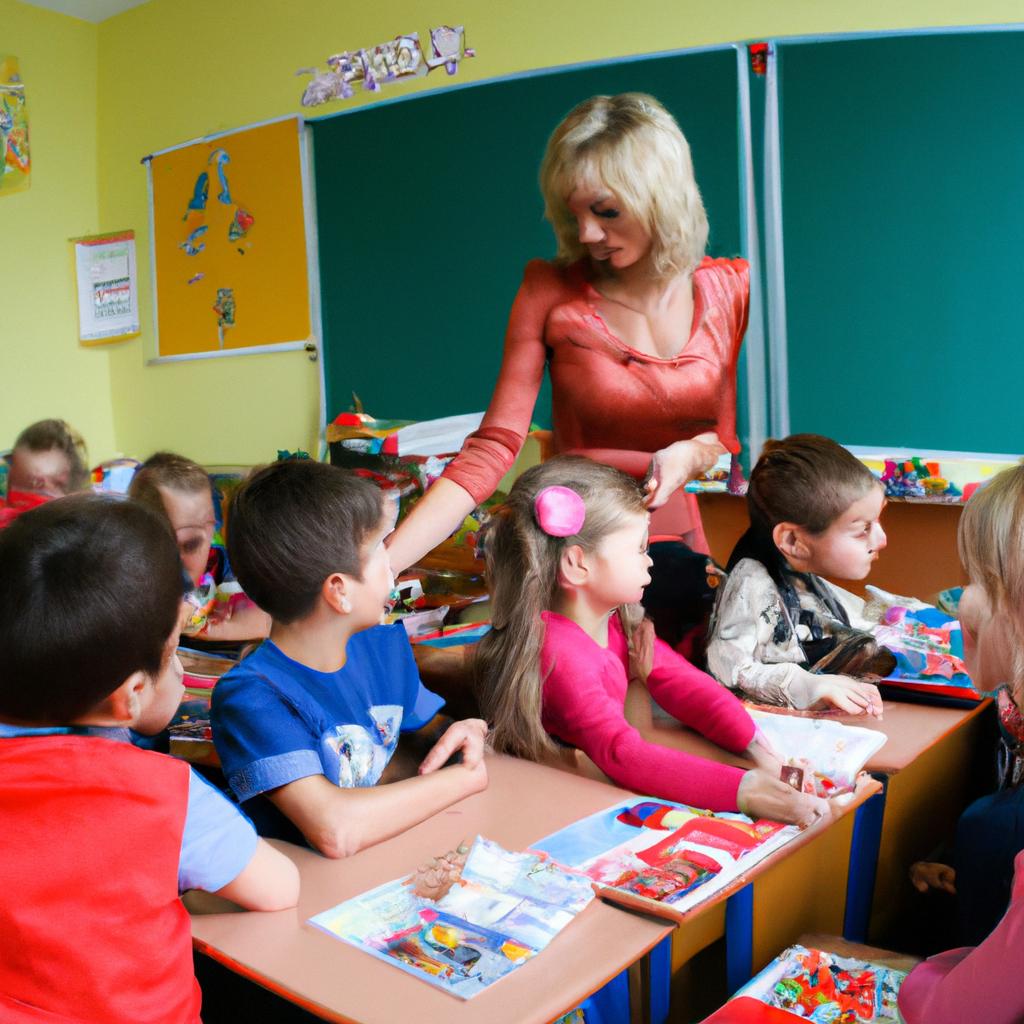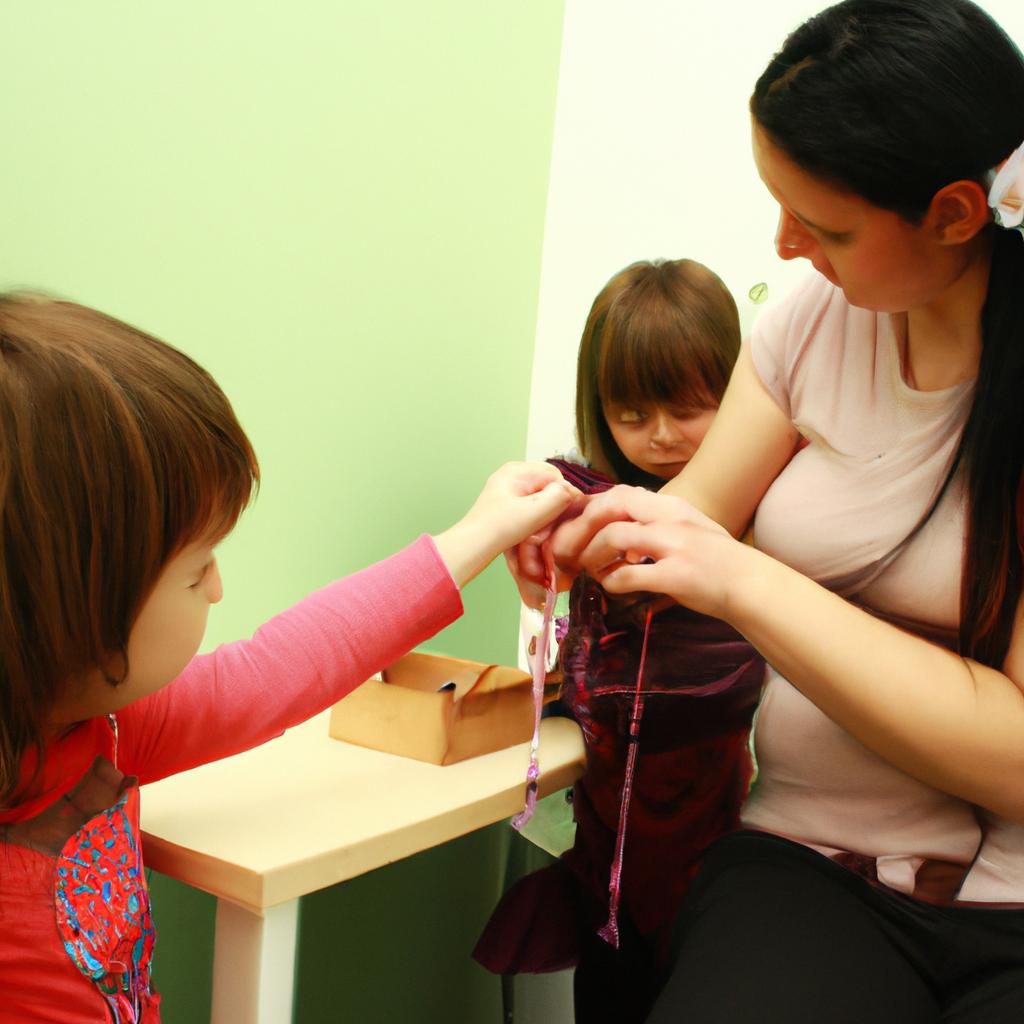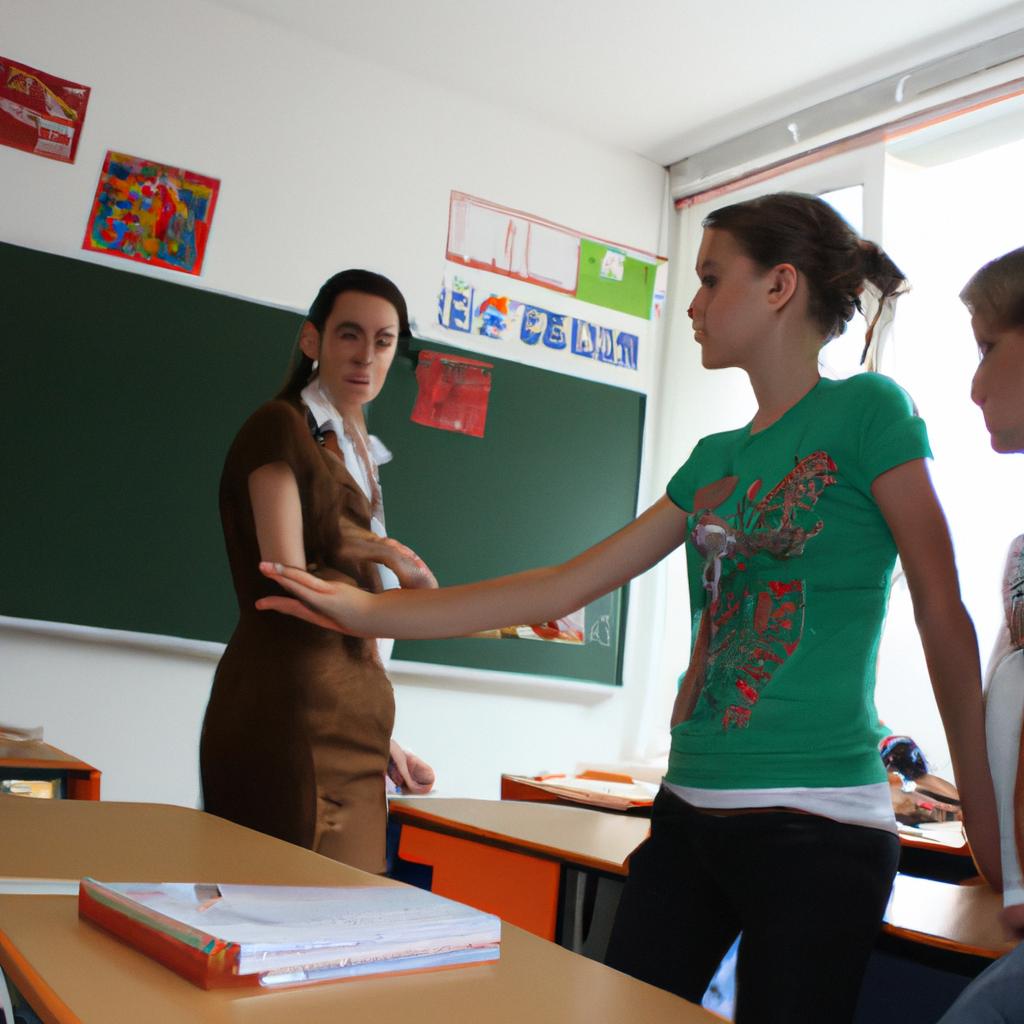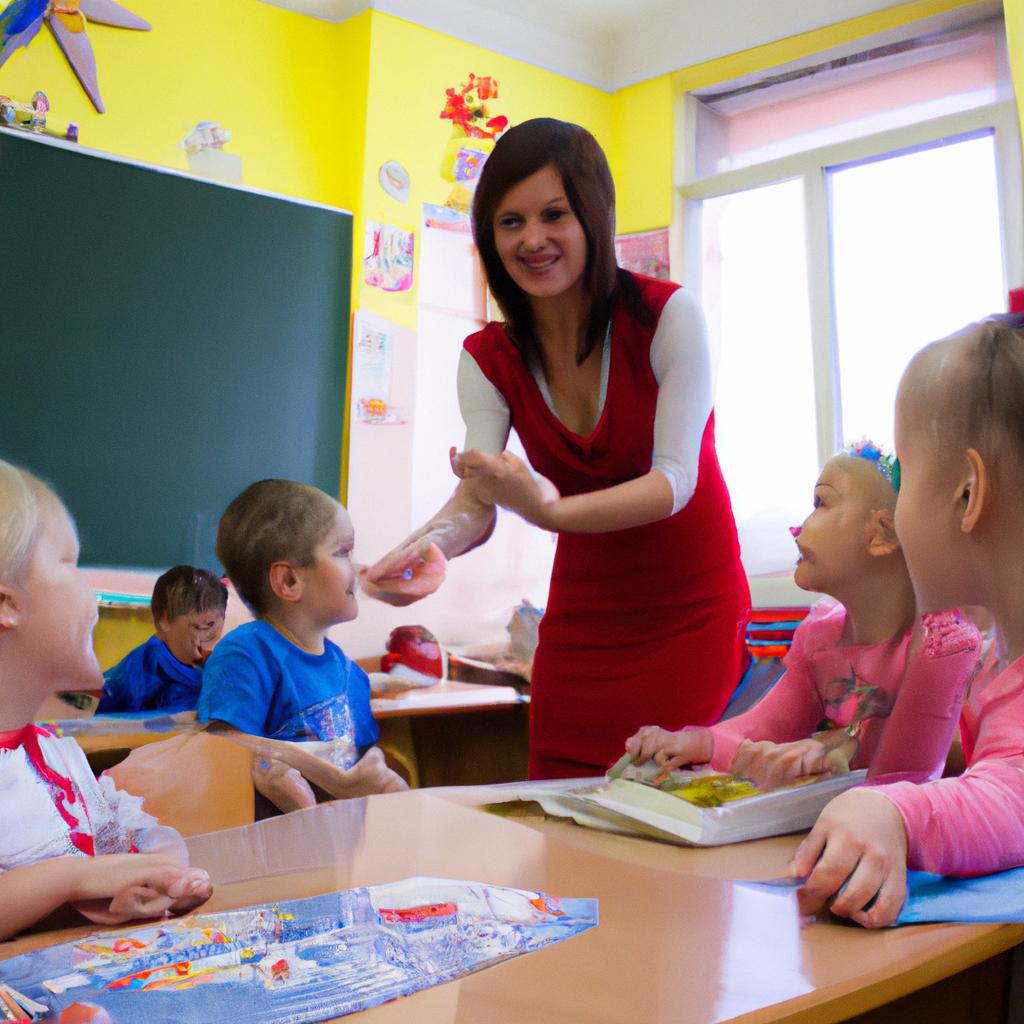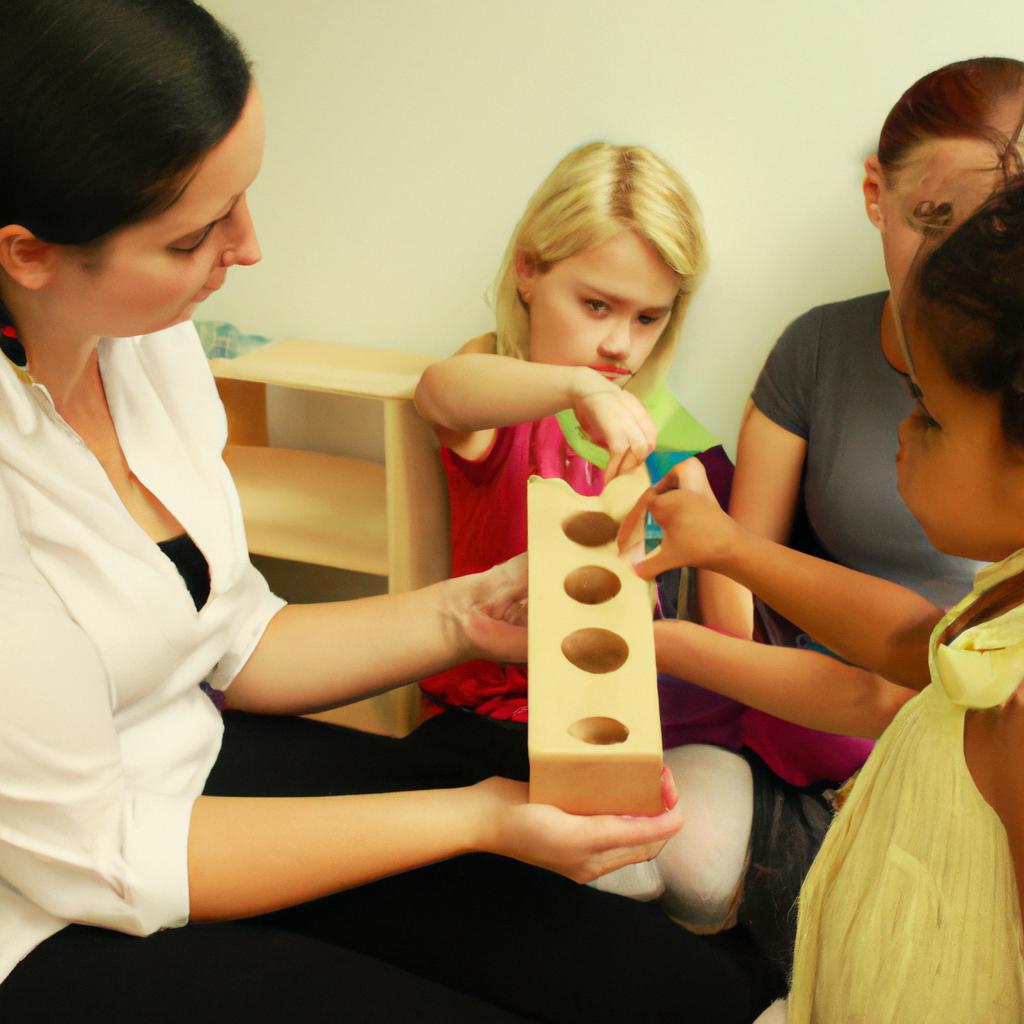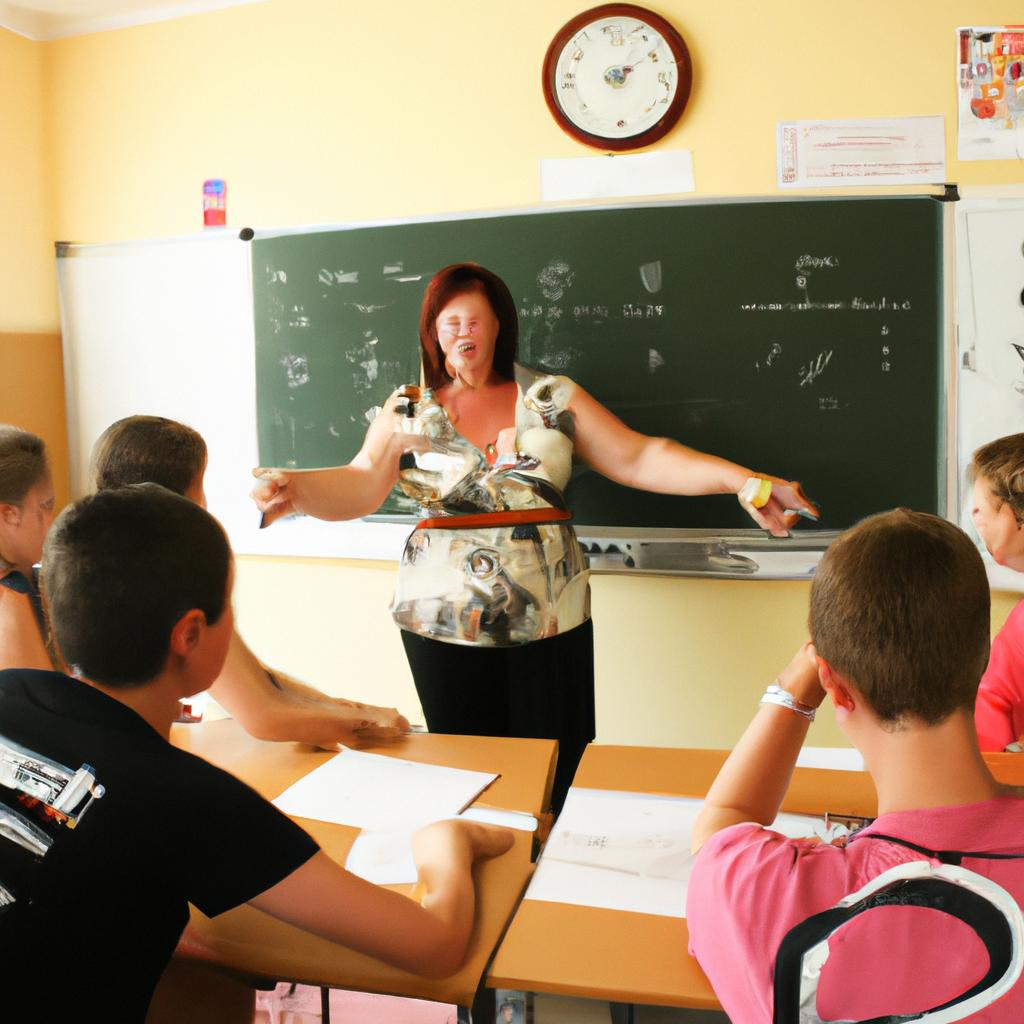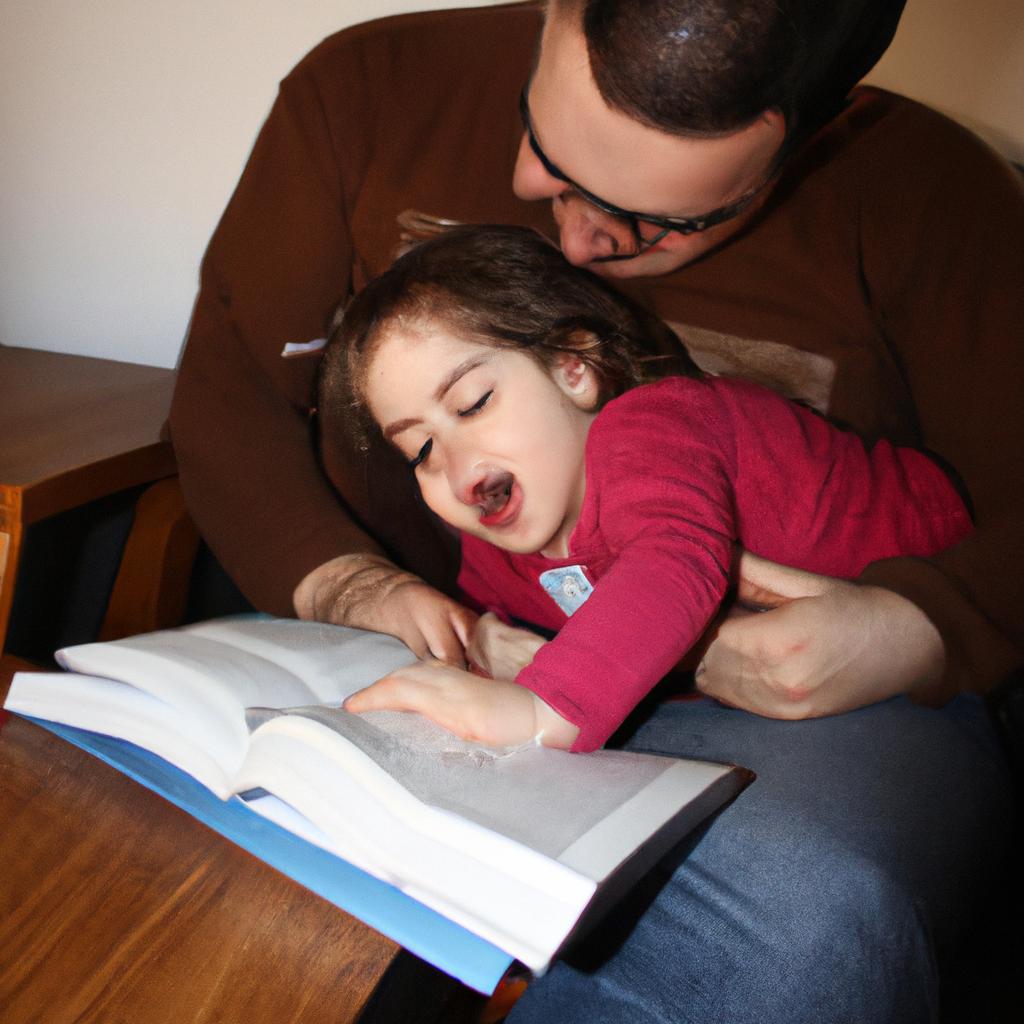Individualized learning has gained significant attention in the field of education due to its potential to cater to the diverse needs and abilities of students. One prominent example of individualized learning is found in Montessori schools, where a unique approach emphasizing self-directed activities and hands-on learning is implemented. For instance, consider a hypothetical case study involving Emma, an elementary school student enrolled in a Montessori program. Unlike traditional classrooms that follow a fixed curriculum for all students, Emma’s Montessori classroom provides her with opportunities to explore various subjects at her own pace and engage in activities based on her interests and current level of understanding.
The implementation of individualized learning in Montessori schools relies heavily on creating an environment that fosters independence and promotes active engagement among students. In these settings, educators serve as facilitators rather than mere instructors, guiding students towards their own discoveries and allowing them to take ownership of their learning journey. This pedagogical approach aims to cultivate critical thinking skills, problem-solving abilities, and a genuine love for learning through personalized experiences tailored to each student’s unique strengths and weaknesses.
By examining the principles behind individualized learning in Montessori schools and exploring its practical application through examples like Emma’s case study, this article seeks to shed light on the benefits and effectiveness of individualized learning in promoting student growth and development.
One benefit of individualized learning in Montessori schools is that it allows students like Emma to have a sense of autonomy and control over their education. By giving them the freedom to choose their activities and work at their own pace, students are more motivated and engaged in their learning process. This approach also fosters self-discipline and responsibility as students learn to manage their time effectively and make decisions about what they want to explore further.
Moreover, individualized learning recognizes that every student has different strengths, interests, and learning styles. In Montessori classrooms, teachers observe each student closely to understand their unique needs and adjust the environment accordingly. For example, if Emma shows a strong interest in science, her teacher may provide her with additional resources or experiments related to this subject. This personalized approach ensures that students receive targeted instruction and support, maximizing their potential for success.
Another advantage of individualized learning is its emphasis on hands-on experiences. Montessori classrooms are equipped with various materials designed to facilitate experiential learning. These materials are carefully selected to promote independent exploration and problem-solving skills. For instance, Emma might use geometric shapes to learn about spatial relationships or manipulate beads to understand mathematical concepts. Such tactile experiences not only enhance comprehension but also foster creativity and critical thinking abilities.
Furthermore, individualized learning helps develop important life skills such as collaboration, communication, and adaptability. In Montessori schools, students often work in mixed-age groups where they collaborate on projects or assist one another in their learning journeys. This interaction encourages empathy, teamwork, and effective communication among peers. Additionally, by allowing students to progress at their own pace, individualized learning promotes adaptability as students learn how to navigate challenges independently while seeking appropriate guidance when needed.
In conclusion, individualized learning in Montessori schools offers numerous advantages for students like Emma by providing them with a tailored and engaging educational experience. Through self-directed activities, hands-on learning, and personalized support from educators, students are empowered to take ownership of their education, develop important skills, and reach their full potential. As the focus on individualized learning continues to grow in the field of education, its impact on student success and overall educational outcomes becomes increasingly evident.
Benefits of Individualized Learning
One example that highlights the benefits of individualized learning is the case study of Sarah, a student who struggled in a traditional classroom setting but thrived when placed in a Montessori school. In this environment, Sarah was given the freedom to choose her own activities and work at her own pace. As a result, she became more engaged in her studies, developed a love for learning, and saw significant improvements in her academic performance.
There are several key benefits associated with individualized learning:
-
Personalization: Individualized learning allows educators to tailor instruction based on each student’s unique needs and abilities. This personalized approach ensures that students receive targeted support and can progress at their own pace.
-
Increased motivation: When students have control over their learning experience, they are more likely to be motivated and actively engaged in their studies. By allowing them to explore topics of interest and take ownership of their education, individualized learning fosters intrinsic motivation.
-
Enhanced problem-solving skills: Through independent exploration and self-directed activities, students develop critical thinking and problem-solving skills. They learn how to analyze information, make connections between concepts, and apply knowledge in real-world situations.
-
Improved social-emotional development: In an individualized learning environment, students often collaborate with peers on projects or seek assistance from teachers as needed. These interactions promote important social skills such as communication, teamwork, empathy, and resilience.
The table below summarizes some emotional responses commonly associated with individualized learning:
| Emotion | Description | Example |
|---|---|---|
| Excitement | A sense of enthusiasm and eagerness | Students eagerly exploring new concepts |
| Confidence | Belief in one’s abilities | Students confidently presenting their work |
| Independence | Freedom to make choices | Students making decisions about their tasks |
| Satisfaction | Contentment and fulfillment | Students feeling proud of their accomplishments |
In summary, individualized learning offers a range of benefits that contribute to students’ academic success and personal growth. By providing personalized instruction, fostering motivation, developing problem-solving skills, and nurturing social-emotional development, this approach creates an optimal environment for students to thrive.
Transitioning into the subsequent section about “Key Features of Montessori Schools,” it is important to examine how these benefits are achieved through specific elements within Montessori education.
Key Features of Montessori Schools
Benefits of Individualized Learning: Montessori School Implementation
Transitioning from the benefits of individualized learning, let us now explore the key features of Montessori schools. To illustrate these features, consider a hypothetical scenario where a child named Emma attends a Montessori school. Emma is provided with personalized learning experiences tailored to her unique needs and interests.
One notable aspect of Montessori education is its emphasis on self-directed learning. In this approach, students like Emma are encouraged to take an active role in their educational journey. They have the freedom to choose activities that align with their personal preferences, allowing them to engage in subjects that genuinely intrigue them. For instance, if Emma has a keen interest in science, she can spend more time exploring experiments or reading books related to this field. This autonomy fosters intrinsic motivation and a love for learning.
Montessori classrooms also promote mixed-age groupings, enabling children to interact with peers at different developmental stages. By being exposed to older children’s knowledge and younger ones’ progress, students like Emma gain valuable socialization skills and learn from each other’s strengths and challenges. This collaborative environment cultivates empathy, leadership qualities, and the ability to work effectively within diverse teams – essential life skills needed in today’s interconnected world.
In addition to these aspects, Montessori schools incorporate various materials and tools specifically designed to facilitate hands-on learning experiences. These manipulative resources stimulate sensory exploration while building cognitive abilities. For example, Emma may use specialized math materials such as number rods or golden beads to understand mathematical concepts through concrete manipulation before moving onto abstract representations.
To evoke an emotional response from the audience regarding the effectiveness of Montessori schools in promoting individualized learning environments:
- Students develop confidence by setting their own pace for learning.
- Children experience joy and curiosity when given choices based on their interests.
- The sense of belonging fostered through mixed-age groupings creates supportive relationships among students.
- The use of hands-on materials enhances engagement and deepens understanding.
The table below summarizes these emotional responses:
| Emotional Response | Description |
|---|---|
| Confidence | Students build self-assurance as they take control of their learning journey. |
| Joy and Curiosity | Children experience excitement and inquisitiveness when provided with choices aligned with their interests. |
| Sense of Belonging | Mixed-age groupings foster a sense of community and belonging, encouraging supportive relationships among students. |
| Engagement and Understanding | Hands-on materials enhance student engagement and promote a deeper understanding of concepts. |
In conclusion, Montessori schools implement individualized learning through features such as self-directed learning, mixed-age groupings, and specialized manipulative resources. By providing personalized experiences tailored to each child’s needs and interests, Montessori education fosters autonomy, socialization skills, and cognitive development. Such an approach nurtures confidence, joy, a sense of belonging, engagement, and understanding within the students’ educational journey.
Moving forward to explore the role of teachers in facilitating individualized learning…
Role of Teachers in Individualized Learning
Montessori education is characterized by several key features that promote individualized learning. These features are designed to foster independence, exploration, and self-directed discovery among students. One example of these features in action can be seen in a hypothetical case study of a Montessori school where a student named Emma is given the freedom to choose her own activities within a structured environment.
Firstly, Montessori classrooms are carefully prepared environments that provide students with access to a wide range of materials and resources. This allows for independent learning and encourages children like Emma to explore areas of interest at their own pace. For instance, in this case study, Emma might choose to work on a math activity using manipulatives or engage in practical life exercises such as pouring water from one container to another.
Secondly, the role of the teacher in Montessori schools is distinct compared to traditional educational settings. Teachers act as guides or facilitators rather than authoritative figures. They observe each child’s progress and offer individualized guidance when necessary. In this scenario, Emma’s teacher would observe her engagement with different activities and step in if she needed assistance or redirection.
Thirdly, Montessori schools emphasize mixed-age groupings where children span multiple age ranges. This approach promotes peer-to-peer learning opportunities and fosters social development skills such as empathy and cooperation. For example, in this setting, older students may mentor younger ones like Emma, providing support and guidance during collaborative projects or daily routines.
Lastly, assessment methods used in Montessori education focus more on observation rather than formal testing. Observing students’ interactions with materials and their ability to concentrate on tasks helps teachers understand their strengths and areas for improvement better. A markdown formatted bullet point list further illustrates how these key features contribute positively to the overall experience:
- Empowers students through choice
- Encourages independence
- Fosters curiosity and intrinsic motivation
- Supports individualized learning paths
Moreover, a markdown formatted table can highlight the benefits of Montessori education:
| Benefits of Montessori Education |
|---|
| Develops critical thinking skills |
| Enhances problem-solving abilities |
| Promotes creativity and imagination |
| Cultivates a love for lifelong learning |
In summary, Montessori schools implement various features that support individualized learning. Through prepared environments, teacher guidance, mixed-age groupings, and alternative assessment methods, students like Emma are empowered to take ownership of their educational journey in an environment conducive to exploration and self-discovery. This emphasis on individualization sets the stage for the subsequent section about the importance of self-directed learning.
Importance of Self-Directed Learning
Transitioning from the crucial role teachers play in individualized learning, it is important to understand the significance of self-directed learning within a Montessori school environment. This approach empowers students to take ownership of their education and allows them to develop essential life skills that extend beyond traditional academic subjects. To illustrate this concept, let us consider an example where a student named Sarah engages in self-directed learning.
Sarah, a fifth-grade student at XYZ Montessori School, has shown great interest in marine biology. With guidance from her teacher, she embarks on a project exploring various marine ecosystems and creating detailed presentations about different species found in these habitats. Through self-directed learning, Sarah not only gains knowledge about marine biology but also hones her research skills, critical thinking abilities, time management techniques, and presentation expertise.
Self-directed learning provides numerous benefits for students within the Montessori educational framework:
- Fosters intrinsic motivation: By allowing students to choose their topics of study, they become more engaged and motivated to learn.
- Encourages independence: Students gain confidence as they make decisions about what and how they want to learn.
- Enhances problem-solving skills: When faced with challenges during their exploration process, students develop problem-solving strategies independently or through collaboration.
- Promotes lifelong learning: By instilling a love for independent inquiry early on, self-directed learning cultivates a passion for continuous learning throughout one’s lifetime.
| Benefits | Description |
|---|---|
| Increased autonomy | Students have greater control over their own education, leading to increased autonomy. |
| Personal growth | Self-directed learning promotes personal growth by encouraging curiosity and exploration. |
| Critical thinking | Students develop critical thinking skills as they navigate through challenging tasks. |
| Self-confidence | Taking charge of their learning journey boosts students’ self-confidence and belief in themselves. |
In summary, self-directed learning serves as a cornerstone of the Montessori approach, empowering students to become active participants in their education. By fostering intrinsic motivation, independence, problem-solving skills, and a lifelong love for learning, this methodology cultivates well-rounded individuals capable of navigating real-world challenges.
Moving forward, we will explore how creating a prepared environment further supports individualized learning within Montessori schools.
Creating a Prepared Environment
Individualized Learning: Montessori School Implementation
Transitioning from the importance of self-directed learning, we now delve into the creation of a prepared environment in the implementation of Montessori education. This section highlights how an intentionally designed setting can support individualized learning and foster independence among students.
To illustrate this concept, imagine a hypothetical scenario where a five-year-old child named Emma attends a Montessori school. Upon entering her classroom, she is greeted with an inviting space that has been meticulously arranged to cater to her developmental needs. The room is organized into distinct areas such as practical life activities, sensorial exploration, language development, and mathematics. Each area contains carefully chosen materials that are accessible at Emma’s height level, enabling her to independently choose activities that capture her interest and challenge her abilities.
A key element in creating a prepared environment is the use of visual cues and organizational structures that guide children towards independent decision-making. For instance, shelves are labeled using simple pictures or words to help Emma identify where each material belongs after she finishes working with it. Additionally, objects within each area are presented in a logical sequence, gradually increasing in complexity as children progress through their learning journey.
The benefits of this intentional design extend beyond mere aesthetics. Research suggests that implementing a well-structured environment enhances student engagement and motivation while reducing distractions. To further emphasize these advantages, consider the following emotional response-inducing bullet points:
- Students feel empowered when they have choices and control over their learning.
- A visually appealing environment creates a sense of calmness and promotes focus.
- Organizational systems allow for easy access to materials, fostering independence.
- An aesthetically pleasing space positively impacts the overall atmosphere and mood.
Furthermore, incorporating interactive elements like tables can enhance the effectiveness of the prepared environment. Below is an example three-column table showcasing how different aspects contribute to optimal individualized learning experiences:
| Aspect | Impact on Individualized Learning | Emotional Response |
|---|---|---|
| Orderliness | Promotes a sense of structure and organization | Sense of security and stability |
| Accessibility | Empowers students to choose their own activities easily | Feeling of autonomy and control |
| Aesthetics | Enhances the overall ambiance, creating an inviting atmosphere | Feelings of calmness and comfort |
In conclusion, the creation of a prepared environment is crucial in facilitating individualized learning within Montessori schools. By thoughtfully organizing materials, utilizing visual cues, and incorporating interactive elements like tables, educators can effectively support student independence while promoting engagement and motivation.
Now let us explore the challenges and considerations that arise during the implementation of Montessori education in a school setting.
Challenges and Considerations in Montessori School Implementation
Transitioning from the creation of a prepared environment, it is essential to consider the challenges and considerations that arise in implementing Montessori schools. This section examines these factors through an objective lens, providing insights into how individualized learning can be effectively implemented.
One challenge faced in Montessori school implementation is the need for specialized training and expertise among educators. Unlike traditional teaching methods, Montessori education requires teachers who are well-versed in child development theories and possess a deep understanding of the Montessori philosophy. For example, Mrs. Johnson, a teacher at XYZ Montessori School, underwent rigorous training on creating engaging materials and facilitating independent exploration before she could successfully implement the approach in her classroom.
Another consideration involves adapting assessment practices to align with the principles of individualized learning. Traditional grading systems may not adequately capture students’ progress or reflect their unique abilities. Instead, alternative assessment strategies such as portfolio assessments or narrative evaluations empower students to showcase their growth holistically. By considering each student’s strengths and areas for improvement within a comprehensive framework, holistic assessments foster intrinsic motivation and encourage lifelong learning.
Furthermore, parental involvement plays a crucial role in supporting individualized learning in Montessori schools. Establishing effective partnerships with parents allows for ongoing communication about students’ progress and encourages collaboration between home and school environments. Through regular parent-teacher conferences and open lines of communication via email or online platforms, parents gain insight into their child’s educational journey while also contributing valuable perspectives that enrich the overall learning experience.
- Engaged parents actively participate in their child’s education.
- Students benefit from consistent support both inside and outside the classroom.
- Parents become advocates for their children’s unique educational needs.
- A strong sense of community fosters trust between families and educators.
Additionally, incorporating emotions impactfully is achieved by presenting information through visual aids like tables. Consider this three-column, four-row table:
| Challenges | Considerations |
|---|---|
| Specialized training and expertise among educators | Adapting assessment practices to align with individualized learning principles |
| Ensuring parental involvement in supporting students’ progress | Establishing effective partnerships between home and school environments |
By addressing these challenges and considerations head-on, Montessori schools can successfully implement individualized learning. The commitment to training educators, adapting assessment strategies, fostering parental involvement, and building collaborative relationships forms the foundation for a transformative educational experience that supports each student’s unique growth and development.

